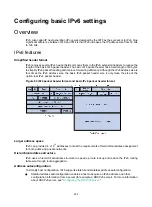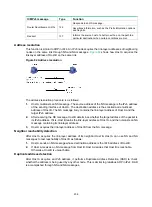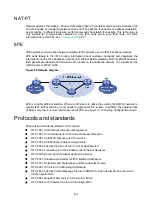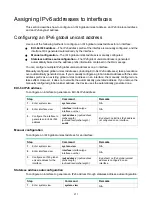
216
Minimizing link-local ND entries
Perform this task to minimize link-local ND entries assigned to the driver. Link-local ND entries refer
to ND entries that contain link-local addresses.
By default, the device assigns all ND entries to the driver. With this function enabled, the device does
not add newly learned link-local ND entries whose link local addresses are not the next hop of any
route into the driver. This saves driver resources.
This function takes effect only on newly learned link-local ND entries.
To minimize link-local ND entries:
Step Command
Remarks
1.
Enter system view.
system-view
N/A
2.
Minimize link-local ND
entries.
ipv6 neighbor link-local
minimize
By default, the device assigns all ND
entries to the driver.
Setting the hop limit
The device advertises the hop limit in RA messages. All RA message receivers use the advertised
value to fill in the Hop Limit field for IPv6 packets to be sent. To disable the device from advertising
the hop limit, use the
ipv6 nd ra hop-limit
unspecified
command.
To set the hop limit:
Step Command
Remarks
1.
Enter system view.
system-view
N/A
2.
Set the Hop Limit field in the IP
header.
ipv6 hop-limit
value
The default setting is 64.
Configuring parameters for RA messages
You can enable an interface to send RA messages, and configure the interval for sending RA
messages and parameters in RA messages. After receiving an RA message, a host can use these
parameters to perform corresponding operations.
describes the configurable parameters in
an RA message.
Table 10 Parameters in an RA message and their descriptions
Parameter Description
Hop Limit
Maximum number of hops in RA messages. A host receiving the RA message fills
the value in the Hop Limit field of sent IPv6 packets.
Prefix information
After receiving the prefix information, the hosts on the same link can perform
stateless autoconfiguration.
MTU
Guarantees that all nodes on the link use the same MTU.
M flag
Determines whether a host uses stateful autoconfiguration to obtain an IPv6
address.
If the M flag is set to 1, the host uses stateful autoconfiguration (for example, from
a DHCPv6 server) to obtain an IPv6 address. Otherwise, the host uses stateless
autoconfiguration to generate an IPv6 address according to its link-layer address
and the prefix information in the RA message.
















































